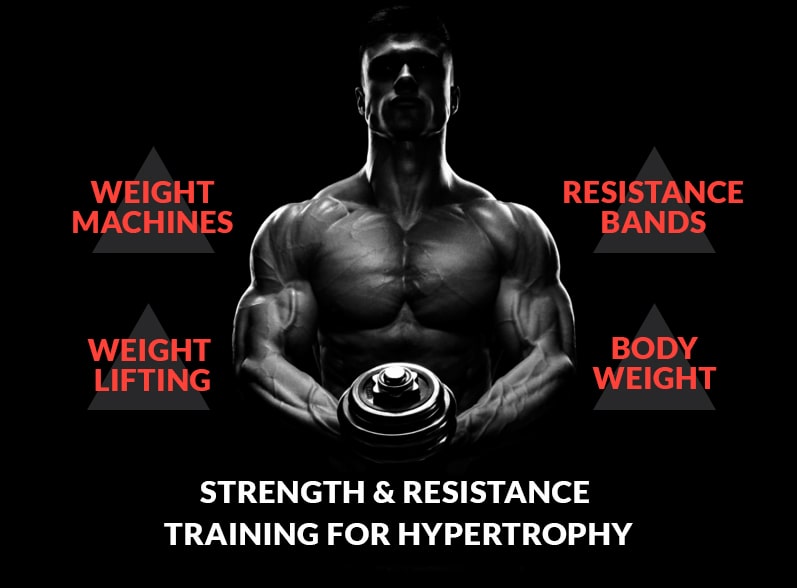When exercising, especially with real goals of achieving a decidedly muscular physique capable of competing athletically, you have to have a solid understanding of physiology and biology. You don’t have to have the expertise that someone working in these fields would have, but still, you need to understand your body to properly wield it and to tune it.
Of course, if you aren’t new to fitness and CrossFit, you have some understanding of a lot of things. You understand respiration and metabolism, you understand nutrition and intern assimilation, etc. But, hypertrophy may be a bit of a foreign concept. What exactly is it, how is it induced, what should you do when it is induced, why is it necessary? These are all things that we will cover today, giving you a better understanding.
What is hypertrophy?
Hypertrophy is a state induced in muscle cells wherein they reproduce rapidly. Basically, the old saying that you have to break muscles to make muscles is indeed true. When you overwork your muscles, this damages many muscle cells, and causes the stimulus and the cells to not only reproduce enough to repair the damage, but to build an excess or surplus of muscle cells to compensate and prevent the stress in the future. The body basically anticipates that the same stress stimuli will occur again, and it will be ready for it. Were it not for this, it would be impossible for exercises to build muscle, meaning that we would all be cursed with the musculature we are born with, forever unable to achieve any gains.
Hypertrophy is accompanied by discomfort. This goes above and beyond simple fatigue in your muscles, being punctuated by soreness, aching and even occasional numbness in extreme cases. It will also be accompanied by a sense of sharp heat emanating from within your body.
Types of Muscle Hypertrophy
Muscle hypertrophy occurs on two levels.
Sarcoplasmic Hypertrophy
Muscles contain a compound called sarcoplasm, which is absolutely necessary for their mechanical functioning, as is another component, the myofibril. Increases of sarcoplasm, which in simple terms improves the effectiveness of a muscle cell, are known as sarcoplasmic hypertrophy. This is generally easier to induce, and bulks up and enhances the tone, definition and strength of existing muscles.
Myofibrillar Hypertrophy
Damage to the myofibrils, on the other hand, results in myofibrillar hypertrophy, which also results in growth of muscles, but is also believed to stimulate the reproduction of muscle cells. This requires active damaging of cells, which is accompanied by pain and discomfort.
Hypertrophy Meaning and Definition
What is the meaning of hypertrophy? To define hypertrophy, it’s basically the increase of muscular volume, number of muscular cells, as well as a general bulking and increased definition to musculature. This also is accompanied by strengthening of muscle fiber due to stimuli from damaging impacts created by exercise and stressing of muscle tissue.
That is essentially what hypertrophy means, at the end of the day. So keep on practicing those air squats, squat cleans and dumbbell trusters.
What Causes Muscle Hypertrophy and How Does it Work?
How does hypertrophy work? What causes muscle hypertrophy? The answer to this is pretty simple. You simply have to stress your muscles beyond the capacity for which they are currently designed. The human body responds to stimuli and adjusts accordingly. If you don’t use muscles, the body will gradually redirect its resources elsewhere, and it will atrophy. Notice that word, atrophy? It’s the opposite of hyper trophy, where muscle tissue increases in volume and increases in cell count.
If muscles are stressed often enough, they will grow and increase in strength as a result of the stimuli. Workouts, therefore, which stress your muscles to their limits, will induce hypertrophy. You have to constantly challenge your limits, though within safe limitations. If you only exercise within your current comfortable limits, you’ll maintain your physique, but will see no muscular gains.
We’ll get to the best ways to induce hypertrophy shortly, and what to do to help get the most out of your currently-induced state of hyper trophy.
Hypertrophy Training: What You Need to Know
To train for hypertrophy, you really don’t need some sort of advanced knowledge, particularly fancy equipment or some secret regime passed on from some really swole trainer. A coach is helpful, but the point here is that hypertrophy training is actually surprisingly simple.
A hypertrophy workout simply consists of repeated reps that go above and beyond your current comfort levels, stressing your muscles. The particular types of reps and exercises you do are up to your preferences, as well as the particular muscles you’re targeting. Only the specific muscles targeted will have hypertrophy induced, as stress of these muscles is the signal in stimulus that causes it to activate.
You can actually induce hypertrophy simply by doing squats while holding weights, going for significantly long, stressful runs for your legs, or lifting very heavy jobs filled with water, etc. The point is, you don’t need fancy gym equipment to do this, though equipment is a much easier solution if you have a local gym you like, or don’t mind purchasing some home equipment.
It’s important to know your limits, however. While you should exceed your comfort limit, inducing a point where your muscles feel pain, heat and fatigue, you can seriously injure yourself by pushing it too far. Once you have achieved that feeling of discomfort, it’s time to realise that you’ve hit your limits, do some more reps, at this extreme, and call it quits. If the pain becomes so intense that it distracts you even after achieving exercise discipline, you have exceeded safe limits.
Since hypertrophy training requires stressing your body and inducing somewhat painful strain on your muscles, you should probably never do these exercises alone, always having a spotter even when not lifting weights.
Here are a few exercises that will help you achieve hypertrophy for sure:
➜ Deadlift
How Often to Exercise to Achieve Muscular Hypertrophy?
This depends on the individual to some degree. However, it’s generally agreed that you should exercise no less than three times a week, probably two of them in a row, with a rest. Between it in the third one. However, if you are serious about gains, exercising for hyper trophy four days a week is entirely safe to do, provided you know your limits.
If you really want to know how to maximize hypertrophy, a four-day regime with two days, a rest period, a third day, another rest period, and a fourth day is one of the more popular waste space things out. The two days back to back our true stress periods for your muscles, while the third and fourth days are really just to encourage the hypertrophy to last and endure, getting more gains while also helping you maintain your current physique. These other two days, the one spaced apart, are more about general balanced exercise with only a small amount of hypertrophy-centric muscle-stressing exercises being included.
How Many Reps are Required for Hypertrophy?
If you are interested in how many reps for hypertrophy, this again depends a little bit on the individual. However, most experts agree that the general, average set of reps for hyper trophy is around three sets of 15.
This may vary, as I said, depending on the person, with some people preferring 12 reps per set, others preferring more vigorous sets if they are already considerably muscular, and are having a hard time getting much more build up from there workout routine.
It’s important to note, though, that if you reach a point where you are considerably muscular, and you aren’t getting a lot of gains from a considerably intense routine, you may have reached your limit as far as muscles go. You run a risk of seriously injuring yourself by pushing too far, and there is an upper limit to how much musculature any given genetic makeup will allow!
Hypertrophy vs Hypotrophy: What’s the Difference?
So let’s talk a minute about hypertrophy vs hypotrophy. We’ve defined hypertrophy as the increase of muscle volume and muscle cells, and we have pointed out the term atrophy, which is a more common and well-known term for the diminishing of an organ or bodily structure due to cell loss. However, specifically when it comes to muscles and some other organs, the term hypotrophy is used to describe a decrease of cells.
Final Hypertrophic Advice
So, here’s a little bit of extra advice for you. You now know how to induce hypertrophy, and you know what it feels like to sense when it’s achieved. You understand what it is, and hopefully you understand the importance of safety and knowing your true limits, not pushing yourself too far, only far enough to induce gains in your musculature.
Once hypertrophy is induced, certain protein compounds and nutritional mixes are a great idea, providing your muscles with an excellent and rapid source of protein from which to rebuild. This will increase the amount of musculature gained during an instance of hypertrophy, though the results vary greatly from person to person and depending entirely on the protein mixes and nutritional compounds you use.
As said before, never exercise for hyper trophy without someone else around, you always run the risk of accidentally pushing yourself too far, damaging a muscle severely enough to require medical attention. You should also consult with both a trainer and a nutritional specialist if you are looking to work up a more muscular physique. They understand this, and based on your body and your genetic makeup, they can provide the best advice on nutrition and exercise regimes to optimize both your hypertrophy as well as other gains from exercise.



